
The peaks of the Dolomites are characteristically steep, with huge faces and towering summits often breaching 3000m in altitude. These stunning spires of alpine limestone are located south of the Austrian / Italian border and the mountainous area extends for 80km east of the town of Bolzano.
Located in northern Italy and with a unique mix of Italian and Austrian culture, the Dolomites is home to some of the grandest yet accessible climbing and via ferrata in the world. The area is steeped in history and peppered with the names of some of mountaineering's greatest historical figures - Comici, Lacedelli, Mariacher, Messner, Piaz, Preuss, Vinatzer and Huber to name but a few.
The Dolomites are one of Europe's most complete and varied climbing destinations, where both the enthusiastic novice and seasoned veteran are catered for in abundance; single pitch sport crags sit next to kilometre-long traditional routes; historical 'rites of passage' run parallel to modern bolted desperates. The via ferrata give relatively straightforward access to some of the world's most striking summits, their metal wires interspersed with breathtaking ladders and unlikely suspension bridges. These provide aerial assault courses which combine the thrill of an ascent on rock with the security of a protected mountain scramble. All of this takes place in a scenically stunning and unique environment, the bright alpine meadows and blue sky lending colour to these so-called 'Pale Alps'.
"single pitch sport crags sit next to kilometre-long traditional routes" - James Rushforth
Read James Rushforth's other Dolomites articles:
Climbing the Comici
Dolomites - Ice, Mixed and Drytooling
The Dolomites - Via Ferrata
Dolomites - Ski Mountaineering and Snowshoeing
The Dolomites - 5 Easy Route Recommendations
Trad / multi pitch sport climbing in the Dolomites
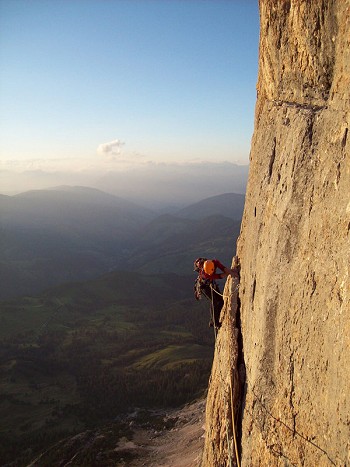
Alex Huber talking about his upbringing in the Dolomites.
The Dolomites are particularly famous for providing some of the longest multi-pitch trad and sport climbing in the world. The scale of the walls combined with the stunning scenary make for some very memorable outings. Despite the Dolomites enjoying a somewhat fearsome reputation there are many excellent easy climbs to be found, just bear in mind that 9 pitches equates to a relatively short route and thus parties need to be relatively experienced despite the modest grades. For those looking for something a bit more relaxing the area also has the highest concentration of via ferrata in the world (see below).
Route finding - Route finding in the Dolomites is notoriously difficult, primarily because routes often don't follow the main line of weakness as they do on other rock types such as granite. To further confuse things, there are sometimes many possible variants, even on the classic climbs. Be wary of blindly following a line of pegs as this may well be a harder variant, project route, or indeed a failed attempt at a new route. Furthermore the scale of the climbs gives you more opportunities to go wrong, especially on the easier sections where the line is less crucial.
It is worth spending some time on the valley floor, committing the route line to memory and mentally marking key features; an obvious-looking line seen from the ground is nearly always less apparent once on the route.

Protection - On the majority of trad routes in the area there is usually a variety of fixed gear of varying quality, most notably on the crux pitches which often contain a lot of pegs dating back to old aid ascents. However these are rarely found in sufficient number to protect the entire climb and some of the climbs can be run out. Thus in addition to your rock shoes, helmet, harness and chalk bag you will need a decent range of other gear.
- Runners - The length of many of the routes means a fairly light rack is essential to moving quickly. A typical multi-pitch rack will be based around a set of wires with a few duplicates in the smaller sizes, and three to four medium-sized cams. Many people find a set of tri-cams particularly useful for protecting the pockets found in dolomite rock. For those attempting the harder climbs a set of micro nuts and cams are useful, whilst parties attempting some of the extreme routes will benefit from taking a few skyhooks.
- Slings - In addition to this metalware, you will also need a good number of slings for the numerous threads and for building fast and efficient belays. Some tat can also be useful for equalising abseil anchors (don't be afraid to take a knife to some of the stations and start over). A set of prusiks is mandatory for the many traverses and abseil descents. A belay plate that can operate in 'guide mode' is advisable to assist with moving quickly. Finally a good amount of extenders or quickdraws of varying lengths to help keep rope drag to a minimum is advised. The sport climbs need between 12 and 18 quickdraws depending on their length.
- Pegs/Pitons - From a British and increasingly modern climbing perspective the placing of pegs on summer alpine rock routes should be avoided if possible. On new routes or climbs of extreme difficulty it may be necessary, but for the majority of routes in this book they are not required. It could be argued that a set of pegs is a good idea as a safety precaution for retreat from the less well-travelled routes on the Marmolada South Face and other faces of a similar scale; ultimately this is up to individual parties to decide.
- Ropes - Trad - A pair of double ropes (either 50m or 60m) is required for most of the routes in this book. This is because of the frequent need to make large abseils and to reduce rope drag. Sport routes - A single rope of at least 60m is recommended for single pitch sport climbing in the Dolomites. A 70m rope is useful for Tridentina crag and Sass Dlacia, whilst an 80m rope is required for many of the (hard) routes at Eiszeit. For much of the multi-pitch sport a pair of 60m doubles is recommended for the added versatility when abseiling.
- Shoes - Though choosing climbing footwear may seem relatively simple, the hot weather and length of the routes means that a comfortable pair of rock shoes is essential. Velcro fastenings are useful so the shoes can easily be slipped off at stances, although make sure you don't lose them on hanging belays! It is also worth paying some thought to your approach shoes. The steep descents, often on scree, are far more comfortable in a pair of lightweight approach shoes than tight climbing shoes. Clip them to the back of your harness or pop them in your bag; you will be glad you did.
- Bivvy Gear - Some of the routes covered in this book, particularly on the South Face of the Marmolada, are so long that it is normal to make two-day ascents. If you are planning to bivvy on the face you will need other gear such as extra warm clothing or a sleeping bag, extra food and plenty of water. It should be noted though that climbs in the Dolomites generally benefit from a fast and light approach, so avoiding a bivvy where possible is to be recommended. Remember, if you take everything you may need, it will slow you down so much that you will probably end up using it.
- Other Gear - The scale of the routes found in the Dolomites means that most parties choose to climb with a rucksack. It is generally better for both the leader and second to climb with a small sack, rather than loading up the second with a heavy bag (which quickly gets tiring). Some food and water as well as a lightweight windproof/waterproof layer is advised. A headtorch for each climber should be included for all climbs of moderate length and longer - attempting to abseil in the dark is not fun! A reliable mobile phone with a good battery for emergencies is recommended.
Time - The Brits in general are not renowned for their multi-pitch speed at the best of times, probably due to a lack of long routes where moving fast is essential to success. So make sure you leave yourself plenty of time! The guidebook times are often 'best' times assuming you don't have any rests or route finding problems. Make sure you practice moving quickly with your partner on easier climbs and see how you are faring against the guidebook times. For advice on moving quickly it's worth consulting Rich's UKC article: Secrets of the Alpine Ninja.
Weather - As always in the mountains the weather can change very quickly. Make sure you prepare accordingly, don't get caught out! I find the Arabba-based forecasting station to be the most accurate forecast (updated at 4pm each day).
Some photographic inspiration...
Via ferrata in the Dolomites
Via ferrata roughly translate into English as 'iron way', 'iron road' or 'iron path'. They are scrambles or easy climbs that are equipped with cables that are attached to the rock at intervals for safety. Some people like to climb the rock wherever possible; others will use the cables as a handrail. Either way it's an exciting and popular activity that offers a quick and safe way of moving through the sort of terrain that would normally require extensive rope work. The Dolomites has the highest concentration of via ferrata in the world, boasting some 170 routes, the majority of which were put up during the first world war.
The via ferrata are a superb way of accessing some of the Dolomites most spectacular peaks in relative safety. Again there is something for everyone with a huge range of difficulties spread over the area, from protected paths to steep and even slightly overhanging climbing. Whilst the classics are undeniably busy there are many routes that can be enjoyed in solitude with a very small chance of meeting other parties.
Please see The Dolomites - Via Ferrata article for a more indepth look at via ferrata within the area.
Some photographic inspiration...
Guidebooks

There are a number of guidebooks detailing the climbs in the Dolomites. Here are some of the ones I find most helpful:
The Dolomites: Rock Climbs and Via Ferrata
This guide covers everything you need for a climbing trip regardless of ability, whether it be sport, trad, via ferrata or a combination of all three. It features all the major areas and is the only guidebook available to have such comprehensive coverage. Tom Ripley's review can be found here.
Dolomiten
A German guidebook covering 50 of the best trad routes in the Dolomites, illustrated with some superb photography.
Classic Dolomite Climbs
A guidebook covering 102 selected trad climbs in the Dolomites. Translated into English.
Dolomites West & East
General guide in English covering selected trad climbs in the West and East Dolomites.
Western Dolomites 1 and 2 (2011) by Emiliano Zorzi
A general trad guide, translated into English covering the central Dolomites and Pala, in two volumes.
Via Ferrata in the Italian Dolomites: Vol 1 & 2
A dedicated via ferrata guide, written in English covering the North, Central and Eastern Dolomites.
Arrampicare in Val Gardena (2009) by Mauro Bernardi
General guide in German and Italian covering the Val Gardena and surrounding area.
Recommendations
There are simply too many climbs to even begin to create a 'best of' list. Instead here are 5 crags that everyone should visit once...
|
Tre Cime The iconic symbol of the Dolomites, the Tre Cime are world famous in the climbing community and as such need little introduction. For the uninitiated there are in fact eleven or so towers that make up the group, but it is the three monoliths and their north faces that have captured the imagination of tourists and climbers alike for years. Cima Grande is the largest at 2999m and its north face makes up one of the prestigious six classic north faces of the Alps. This is not only a venue for the climbing elite however, as scattered around the towers there are many excellent easier routes of varying grades. There are also several excellent via ferrata in the area with stunning views of the north faces. |
|
|
Marmolada South Face The South Face of the Marmolada is one of the most impressive rock walls in the Dolomites, Europe and indeed the world. Rising for over a vertical kilometre in the centre, there are just under 200 recorded routes weaving their way through a sea of immaculate limestone. All of the routes here are serious undertakings and should not be taken lightly (not least because 28 pitches is about the shortest). Classics include Tomasson, Don Quixote, Vinatzer / Messner, Tempi Moderni and of course Attraverso Il Pesce (the Fish). |
|
|
Cinque Torri The Cinque Torri (five towers), perched high on the Falzarego Pass above Cortina, are one of the cornerstones of climbing in this region. The infinite variety of shapes and sizes found within the many towers epitomise Dolomites climbing in all its forms and the Cinque Torri have always been regarded by locals as the ultimate training facility for alpinists and sport climbers alike. |
|
|
Vajolet Towers The Vajolet towers are one of the most famous rock formations in the Dolomites and have become an iconic symbol for climbing |
|
|
Tofana di Rozes South Face This is one of my favourite faces in the Dolomites, offering a face of similar proportions to that found on the north side of Cima Grande, yet offering relative solitude. |
Logistics
When do I go? - Though it is possible to complete climbs during the winter months (some of the via ferrata make for excellent ski tours) generally speaking the rock climbing season runs from June to the start of October. However at the beginning of the season there is often still a lot of snow about and it is usually necessary to seek lower altitude south facing climbs.
Lifts - Most of the lifts open around the third week of June and close in mid September, but it is worth contacting the local tourist offices for exact information if you are planning on using specific lifts during your trip.
Who flies where? - The Dolomites are easily accessible from three airports all a similar distance away. Innsbruck is the closest airport within 2 hours driving distance of the Sella over the Brenner Pass. Cars can be hired from the airport from a number of different companies. Venice Marco Polo is the other main airport within 2 and a half hours drive from the Sella. There are again a number of car hire companies. Alternatively there are several public transport options from Venice; a direct bus runs throughout high season from Venice to the villages surrounding the Sella, or alternatively a more frequent train service runs to Belluno, from where it is then possible to catch a number of buses.
Treviso airport though only small is actually 15 minutes closer than Venice if you can get a flight there. Public transport is available to the centre of Treviso or into Venice, and then you can take a train / bus as above.
Alternatively it is possible to drive from the UK via Germany and Belgium before approaching the Dolomites from the North entering at Pedraces (recently renamed Badia). I usually stay in a hotel near Munich and do the trip in two days.
Hire cars are expensive, around £150 per week. BMC members can get a discount through Hertz.
Accommodation Advertise here
No Premier Listings found in this area
The towns of Arabba, Canazei, Cortina, Corvara, Colfasco, La Ville, Pedraces and Selva are all good locations from which to reach the popular climbing areas. Camping is available in both Colfosco, Cortina and Canazei, and hotels can be found in all of the towns. UKC regular Mike Kann is very knowlegable about the area and runs a nice set of appartments (Casa-Alfredino) near the Marmolada.
Outdoor Shops Advertise here
No Premier Listings found in this area
There are a lot of outdoor shops in any decent sized town. The best are:
Sportler - Treviso - A huge complex and only 2km from the airport there.
K2 - Cortina - A small but fantastic gear shop.
Sport Amplatz - Canazei - One of the best shops in the area.
Sport Kostner - Corvara - A good shop with attatched super-market.
What else is there apart from the climbing? - There is superb walking and via ferrata, the zipwire at Kronplatz (supposed to be the longest in Europe), a high ropes course at Colfosco, horse riding is becoming increasingly popular, as is mountain biking, there is also white water rafting at Brunico, canyoning at Cortina.
Road biking has long been an integral part of the Dolomite mountains and numerous prestigious races take place up the winding and tortuous passes. Apart from the Giro d'Italia, which usually passes through parts of the Dolomites and in particular often features a famous stage by the Tre Cime, the Sella Ronda and the Maratona dles Dolomites see thousands of cyclists taking to the passes.
Wet weather options
One of the most relaxing wet weather options is taking advantage of the many spa facilities in the boutique hotels. Many of these are open to non-residents and are an indulgent way to rest aching muscles and generally get pampered.
There are numerous cultural options with excellent museums such as the Messner Mountain Museum in Brunico, the South Tyrolean Museum of Archeology - home of Otzi the ice man - in Bolzano, and the two Ladin museums in San Martino in Badia and San Cassiano. The three Regole di Cortina museums - Paleontology, Ethnography and Modern Art - offer interesting insights into the history of the rocks themselves and the heritage of the people who lived around them.
Anyone with an interest in more recent history may be interested in the First World War Museum at the Tre Sassi Fort on the Valparola Pass or at the Marmolada mid station.
Climbing Walls Advertise here
No Premier Listings found in this area
JamesRushforth has just completed the new Rockfax guide - The Dolomites : Rock Climbs and Via Ferrata and is currently working on another guide to Italian sport-climbing destination Finale Ligure.
James Rushforth is a professional photographer and you can see his portfolio on Smugmug, and follow him at JamesRushforth.com
- DESTINATION GUIDE: The Dolomites - Via Ferrata 12 Jul, 2015
- The Dolomites - 5 Easy Route Recommendations 4 May, 2015
- Dolomites - Ski Mountaineering and Snowshoeing 26 Mar, 2015
- CAPTURING THE STARS: Night Sky Photography 16 Oct, 2014
- DESTINATION GUIDE: Dolomites - Ice, Mixed and Drytooling 22 Mar, 2012
- Climbing the Comici - VII / E3 5c, Dolomites 21 Apr, 2010



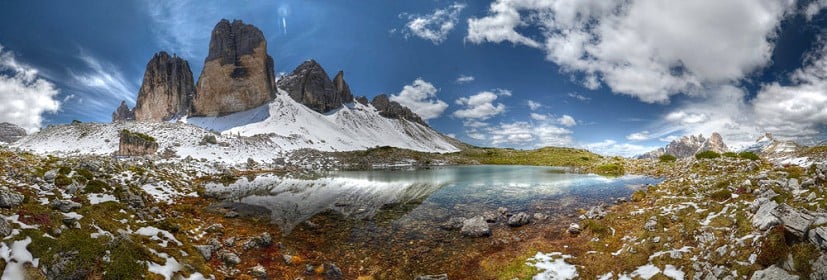
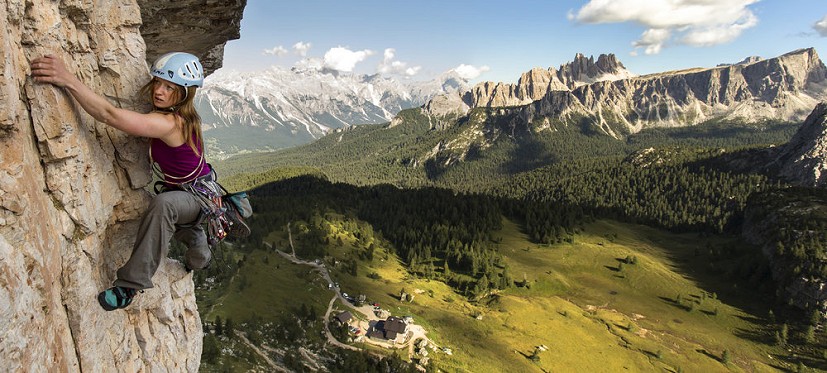
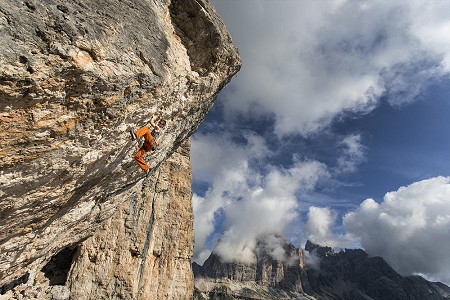
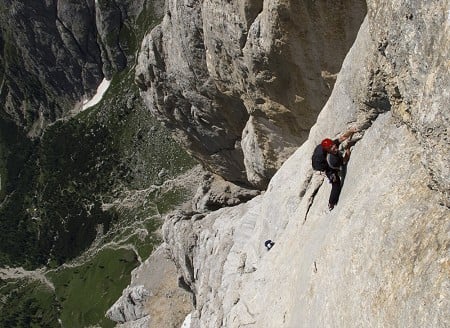
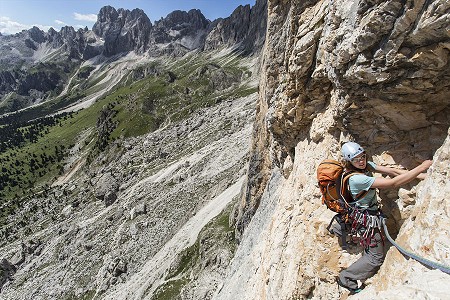
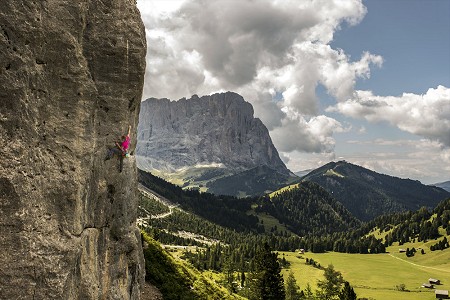
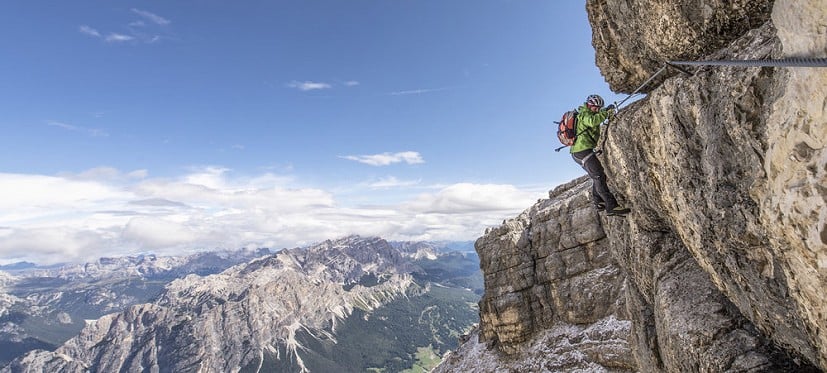
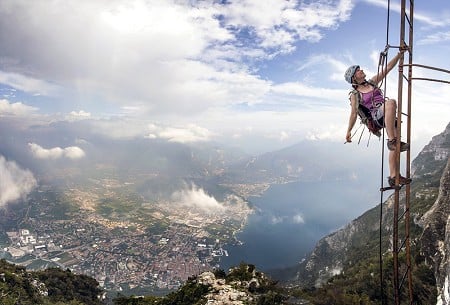
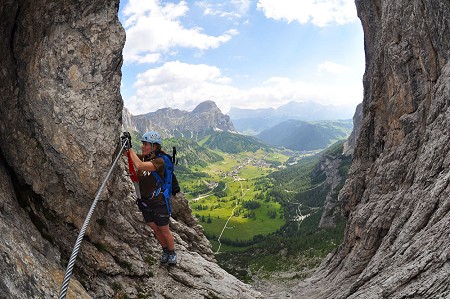
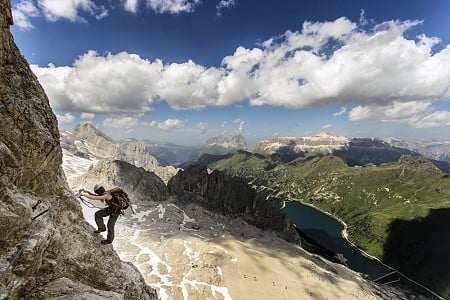
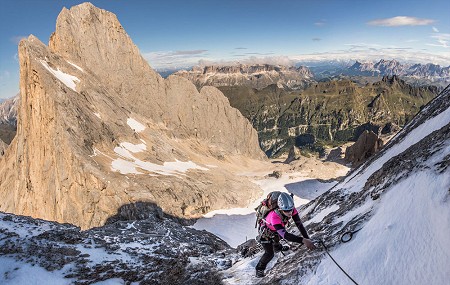
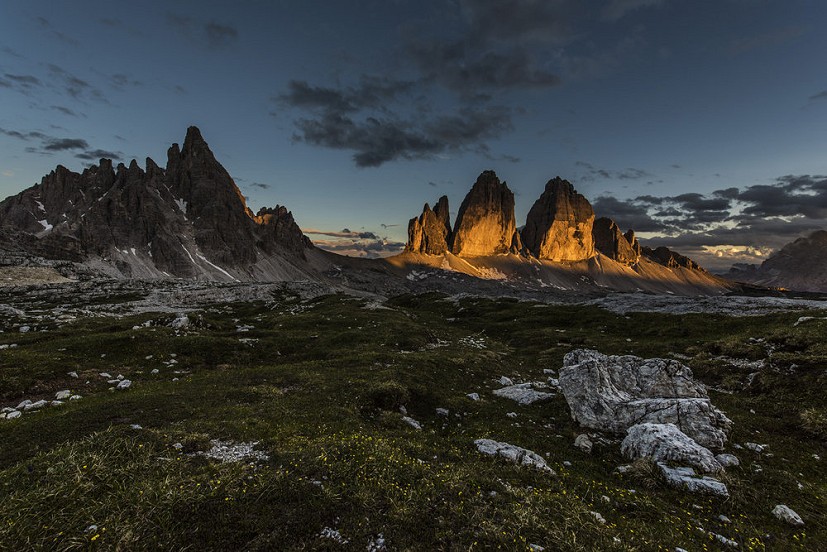


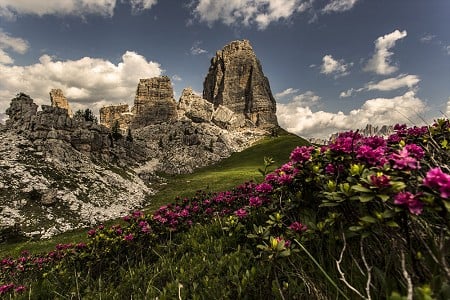

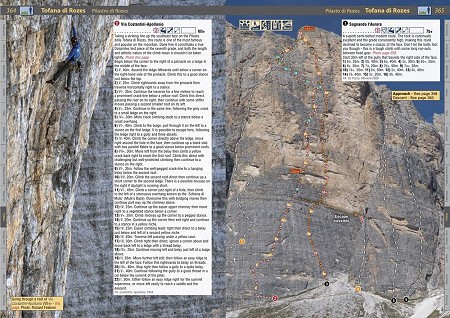
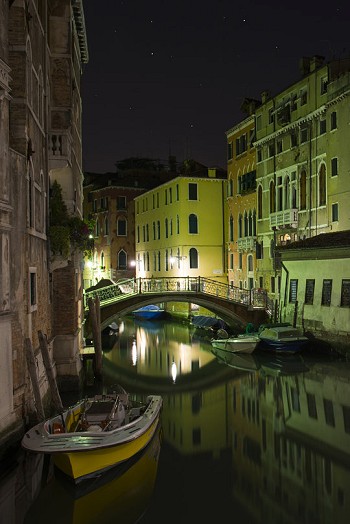
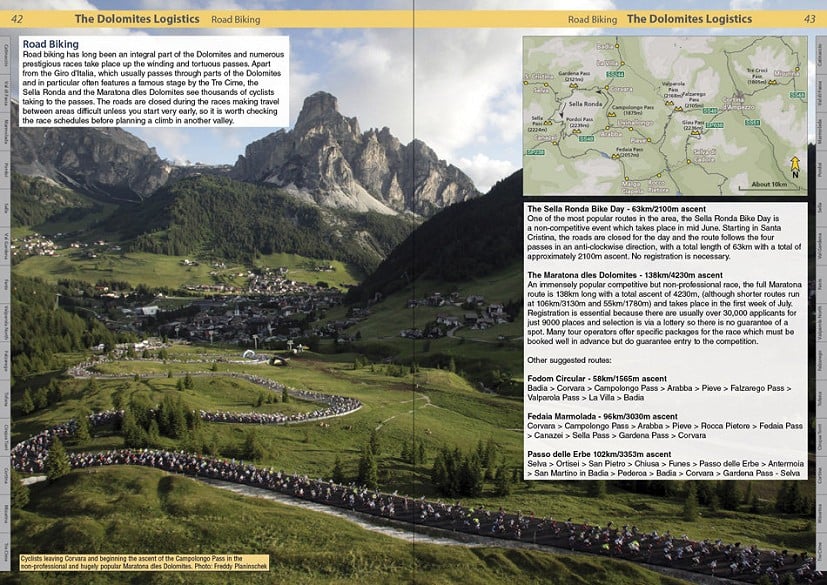

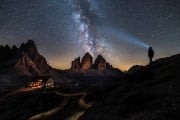
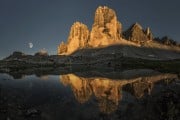
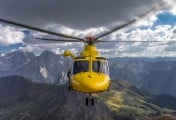
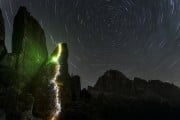

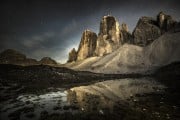




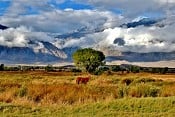

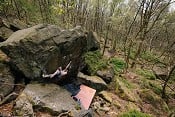
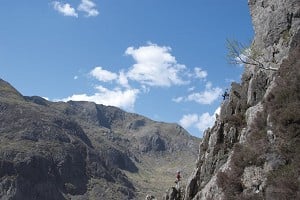





Comments